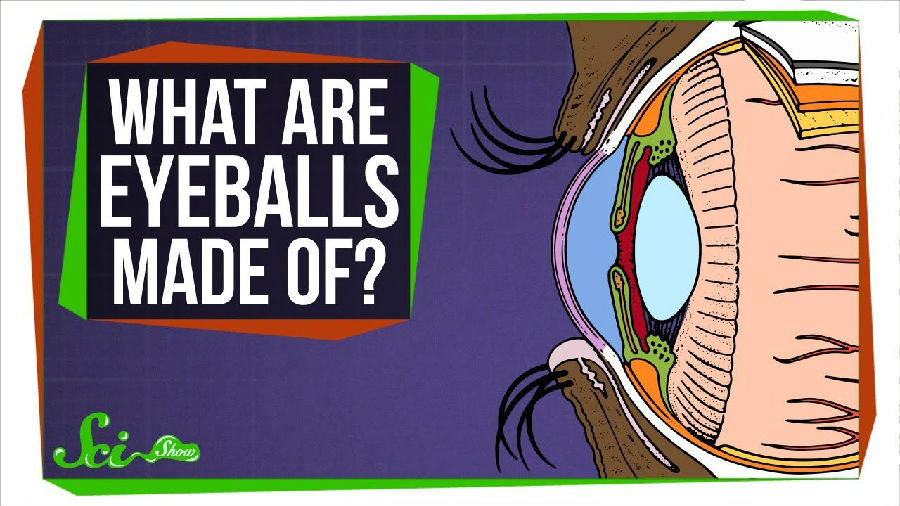SciShow is supported by Squarespace. Whether you need a domain, website, or online store, make it with Squarespace.
本期科学秀由Squarespace赞助播出。找域名、找网站或网上商店,就在Squarespace。
Eyeballs are … weird. They're these strange little blobs that sit inside your skull, and there's nothing else in your body quite like them.
眼球很奇怪。它们是那些坐在你脑壳里边的奇怪小团团,没有一个身体部分像它们这样。
They aren't bone, but they aren't soft like the tissue under your skin, either.
它们不是骨头,也不像皮肤下的组织那样柔软。
Most of your eyeball isn't even that white stuff you see from the outside.
大部分眼球甚至都不像从外边看到的那样是白色的。
Most of your eye is actually a clear, jelly-like type of collagen, the same kind of structural protein that gives your nose and ears their shape.
事实上,多数眼球是透明的胶状胶原质,和给鼻子和耳朵塑形的结构蛋白质相同。
The whiteness you see when you look at your eye is the sclera, the outer layer that holds the whole sac of goo together. But it's just a tough, thin outer coat.
你所看的眼睛的白色部分是巩膜,是将整个粘性囊兜在一起的外层。但这仅仅是一个坚硬的薄外层。
The sclera covers everywhere except the very front of your eyeball, where it connects to the clear tissue that makes up your cornea.
巩膜覆盖住每寸地方,除了你眼球的前端部分,这一部分和构成角膜的透明组织相连。
It's clear so that it lets in light, just so you can actually see. Then there's all that stuff that helps the light get to the back of your eye.
这种透明组织能让光照射进来,这样你才能看得见。然后所有那些物质帮助光线射到眼睛的后边。
After it comes through the cornea, light reaches the colorful part of your eye next, the iris.
在它穿过角膜后,光线到达眼睛的下一个彩色部分,虹膜。
Its main job is to control the size of your pupils so that the right amount of light gets further in.
它主要的工作是控制瞳孔的大小,这样进来的光线才适量。
Directly behind the iris is a lens, a hard, glass-like structure that does exactly what it sounds like: it focuses the light.
在虹膜后边的是晶状体,一种坚硬的玻璃样的结构,就像它的名字一样:它是用于距离光线的。
Meanwhile, the retina, which is actually what does the seeing, is all the way in the back.
同时,视网膜,负责让你看见的物质,一直都在幕后。
It contains light-sensitive cells, as well as the system of nerves that are hooked up to your optic nerve to tell your brain what you're looking at.
视网膜中包含光敏细胞以及神经系统,连接你的视神经,告诉大脑你正在看什么。

But there's still a lot, a lot of space left in your eyeball.
但除此之外,你的眼球还剩很多很多空间。
And most of it, 80% of your eyeball by volume, is the clear, gel-like substance that sits between the retina and the lens.
按体积计,眼球80%的部分都是透明的凝胶状物质,位于视网膜和晶状体之间。
That gooey stuff is called the vitreous humor or the vitreous body, and it's there as a shock absorber and for structural support.
那种胶黏状物质被称为玻璃体,用作缓冲器和结构支撑。
Vitreous humor is latin for 'glassy fluid,' referring to the fact that the goo is clear.
玻璃体是拉丁语‘玻璃状的流体’的意思,因为黏状物是透明的。
Like most gels, it's mostly water, which is mixed with collagen fibers and a kind of sugar called hyaluronic acid.
像多数凝胶剂一样,大部分是水,其中混合了胶原纤维和一种被称为透明质酸的糖。
So yeah. Your eyeball is mostly sweet, gooey collagen.
所以啊,你的眼球大部分是甜甜的胶装的胶原。
There are also lots of other things sprinkled around in really low amounts: more than 120 distinct proteins have been found in the vitreous humor.
其中还撒有很多其他东西,只是量很少:玻璃体中有120多个差异蛋白。
It's actually a littler gooier in the center, and firmer toward the edges. And as you age, it all gets a bit more liquidy.
中间部分其实有很少的黏黏感,边缘处较为坚硬。随年纪增长,会变得更像液体。
That can cause it to separate from the retina in some places, casting those little moving shadows we call floaters.
这样会引起一些地方视网膜的分离,造成那些小的移动阴影,我们称之为飞蚊症。
There's also another fluid, called the aqueous humor, in front of the lens, sandwiched between your iris and your cornea.
还有另一种流体被称为眼房水,在晶状体的前边,夹在巩膜和角膜之间。
That gel takes up most of the remaining 20% of your eyeball's volume, and as the name suggests, it's more watery than the vitreous humor.
那种凝胶物占剩余20%眼球体积的大部分,就像它的名字一样,它比玻璃体要水润得多。
It's there to nourish your cornea, in addition to making sure your eye remains the right shape.
除了确保眼睛形状良好外,在那里才能滋养你的角膜。
What it doesn't contain is blood, or hemoglobin, or any other way of delivering oxygen to those see-through cells in the front.
眼球中没有血、血红蛋白或任何其他想前端透明细胞传送氧气的方式。
Which makes sense, because you wouldn't want red stuff getting in the way of you seeing things. The cornea doesn't have blood, either, or it wouldn't be clear.
这也说得通,因为你也不想在看东西的时候眼前出现红色的物质。角膜中也没有血,它也不是透明的。
So it has to get the oxygen it needs another way: from the gas dissolved in your tears.
所以它必须以另一方式获取所需的氧气:从眼泪中溶入的气体中获取。
Which means… your cornea basically breathes on its own. Your eyeball. Breathes.
这就是说...你的角膜是会自己呼吸的。你的眼球啊,会呼吸哟。
There's not a lot of oxygen in tears, but it's just enough to give the corneal cells what they need to stay alive so the whole sack of goo doesn't fall apart.
眼泪中并没有很多氧气,但是其中氧量足以让角膜细胞存活,这样整个粘性囊就不会分离。











